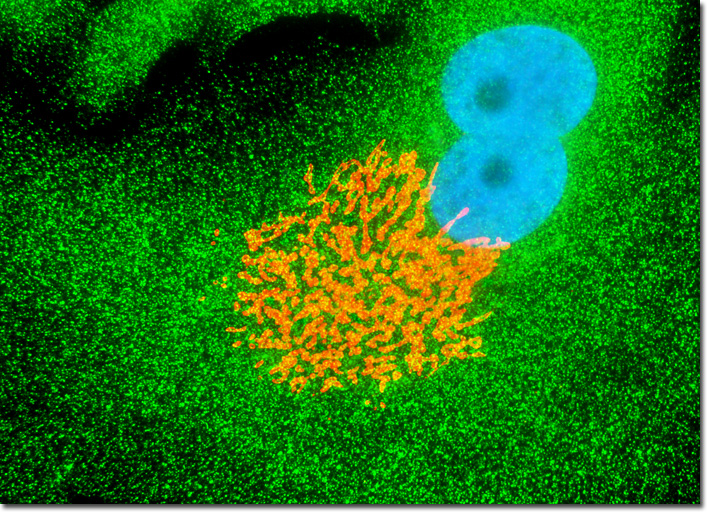Fluorescence Digital Image Gallery
Normal African Green Monkey Kidney Epithelial Cells (Vero)
|
The protein clathrin is composed of three heavy chains and three light chains that self-assemble into a triskelion, a structure with three bent legs radiating from a central point. These clathrin triskelions form polyhedral lattices, termed clathrin baskets or coats, on the cytosolic surface of the plasma membrane and the trans face of the Golgi complex. The precise mechanisms involved in the assembly of clathrin baskets remain to be discovered, as are the exact mechanisms associated with the removal of the lattice from budded vesicles. Research strongly suggests, however, that clathrin coats are involved in the process of protein sorting and that a chaperone protein from the hsp70 family acts as an uncoating ATPase, utilizing energy generated by ATP hydrolysis to remove the clathrin basket. The protein auxillin that can be found attached to clathrin-coated vesicles is thought to trigger this action. In a double immunofluorescence experiment, the adherent monolayer culture of African green monkey kidney cells presented above was fixed, permeabilized, blocked with normal goat serum, and treated with a cocktail of mouse anti-clathrin (heavy chain) and rabbit anti-giantin (Golgi) primary antibodies, followed by goat anti-mouse and anti-rabbit secondary antibodies (IgG) conjugated to Alexa Fluor 488 and Alexa Fluor 568, respectively. The nuclei were counterstained with Hoechst 33258. Images were recorded in grayscale with a QImaging Retiga Fast-EXi camera system coupled to an Olympus BX-51 microscope equipped with bandpass emission fluorescence filter optical blocks provided by Omega Optical. During the processing stage, individual image channels were pseudocolored with RGB values corresponding to each of the fluorophore emission spectral profiles. |
© 1995-2025 by Michael W. Davidson and The Florida State University. All Rights Reserved. No images, graphics, software, scripts, or applets may be reproduced or used in any manner without permission from the copyright holders. Use of this website means you agree to all of the Legal Terms and Conditions set forth by the owners.
This website is maintained by our
|
